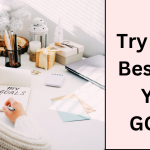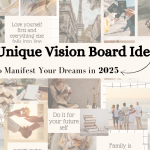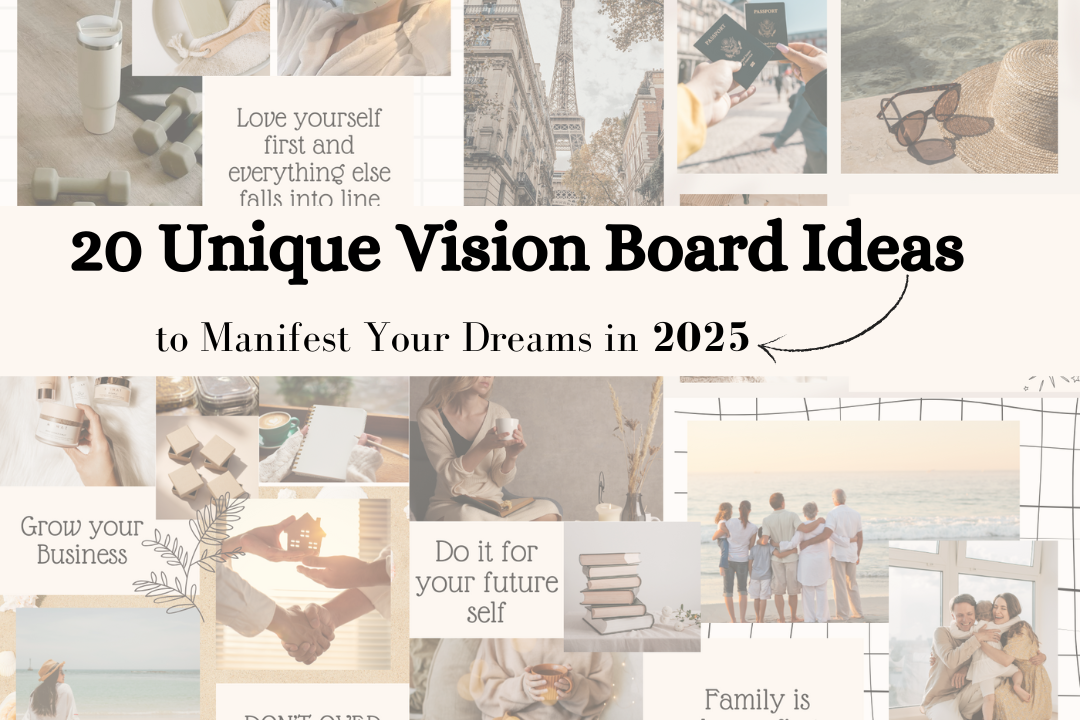
Do you want to turn your dreams into reality? Vision boards are powerful tools for focusing on your goals and aspirations. They work by keeping your intentions at the forefront of your mind, but sometimes, the same old designs can feel uninspiring. That’s why I’ve compiled 20 fresh and unique vision board ideas to spark creativity and elevate your manifestation process. From digital boards to themed creations, there’s something here for everyone.
What is a Vision Board and Why Does It Work?
Vision Board and Its Purpose
A vision board visually represents your goals, dreams, and aspirations. It’s typically a collage of images, words, and symbols that reflect what you want to achieve or manifest in your life. Whether you’re striving for personal growth, career success, or improved relationships, a vision board constantly reminds you of your intentions.
Its primary purpose is to help you clarify your goals, focus your energy, and stay motivated. Having a physical or digital representation of your dreams makes you more likely to take actionable steps toward achieving them.
The Psychology Behind Visualization and Goal-Setting
Vision boards work because they tap into the power of visualization, a psychological technique where imagining success can enhance performance and motivation. Neuroscientists have discovered that the brain processes visual stimuli similarly to real-life experiences. This means regularly seeing your goals on a vision board can create a mental rehearsal that strengthens your belief in achieving them.
Additionally, treating a vision board aligns with the principles of goal-setting theory, which suggests that clear, specific, and visual goals are more likely to be achieved. Writing down and visualizing goals also activates the reticular activating system (RAS), the part of the brain that filters out distractions and focuses on what’s most important.
How Vision Boards Have Helped Others Succeed
- Oprah Winfrey: Oprah is a well-known advocate of vision boards and attributes part of her success to visualizing her dreams. She created vision boards to focus on her personal and professional aspirations, including her Emmy-winning talk show.
- Jim Carrey: Before achieving stardom, Jim Carrey famously wrote himself a $10 million check for “acting services rendered” and visualized success. This act of focused visualization and action helped him achieve that exact amount for his role in Dumb and Dumber.
- Everyday Success Stories:
- A fitness enthusiast created a vision board with photos of healthy meals, workout routines, and inspiring quotes. Within a year, they reached their goal weight and built consistent habits.
- An entrepreneur used a vision board to focus on launching a business. By visualizing the storefront, branding, and customer interactions, they stayed motivated to realize their vision.
These examples highlight that vision boards are not just about wishful thinking. They work when combined with intentional effort and a belief in one’s ability to achieve one’s goals.
Tools and Materials You’ll Need
Essential Supplies for a Physical Vision Board
Creating a physical vision board requires only a few basic supplies, most of which you might already have at home. Here’s a list to get you started:
- Magazines and Newspapers: Source of images, words, and phrases that resonate with your goals.
- Poster Board or Corkboard: The foundation for your vision board. Choose a size that fits your space.
- Scissors: For cutting out images, quotes, and symbols.
- Glue, Tape, or Pins: Adhesives are used to secure items on your board.
- Markers and Pens: Add notes, labels, or creative designs to your board.
- Decorative Elements: Stickers, washi tape, or colored paper to personalize your board.
Digital Tools for Virtual Vision Boards
If you prefer a paperless option, digital vision boards are an excellent alternative. They’re flexible, eco-friendly, and accessible anywhere. Here are some tools to consider:
- Canva: Offers customizable templates for creating digital collages.
- Pinterest: Perfect for collecting and organizing inspiring images and ideas.
- Milanote: An intuitive tool for creating visual boards with drag-and-drop functionality.
- Google Slides or PowerPoint: These are simple options for creating vision boards using text and images.
- Apps like Vision Board or Dream Vision Board: Specialized apps designed for vision board creation and goal tracking.
Pro Tip: Save your digital vision board as your phone or computer wallpaper to keep your goals in front of you daily.
Budget-Friendly Alternatives to Traditional Materials
Vision boards don’t have to break the bank! Here are some cost-effective solutions:
- Recycled Materials: Use old magazines, newspapers, or brochures you already have at home.
- Free Online Resources: Download royalty-free images and quotes from websites like Unsplash or Pexels.
- DIY Supplies: Repurpose cardboard boxes, wrapping paper, or leftover scrapbook materials as your base.
- Digital Free Tools: Stick to free apps or basic software like Canvas Free Plan or Google tools.
- Thrift Shops: Find affordable art supplies, frames, or corkboards.
Creative Tip: Combine physical and digital elements by printing selected images or quotes from online sources to include in your physical board.
20 Unique Vision Board Ideas
1. The Minimalist Vision Board
A minimalist vision board is perfect for those who prefer a clean, uncluttered aesthetic. It focuses on simplicity and clarity, ensuring your goals and aspirations stand out without overwhelming your senses.

Key Features:
- Simple Design: To keep the board visually calming, use a neutral color palette, such as white, beige, or pastel tones.
- Clear Focus: Include only a few key goals or aspirations to maintain clarity and avoid clutter.
- Elegant Layout: Arrange images and text with clean lines and plenty of white space for a polished look.
How to Create It:
- Choose a plain poster board or canvas in a neutral color.
- Select a handful of high-quality images and inspirational quotes that align with your goals.
- Arrange the visuals with ample spacing to maintain an airy feel.
- Subtle embellishments, such as metallic accents, washi tape, or minimalist icons, can add elegance without distracting from the main focus.
Example Goals:
- Save for a dream vacation.
- Focus on mindfulness and minimalism.
- Achieve work-life balance by simplifying daily routines.
4. The Digital Vision Board
The digital vision board is a modern and portable alternative to traditional boards, perfect for tech-savvy individuals who prefer flexibility and easy access to their goals.
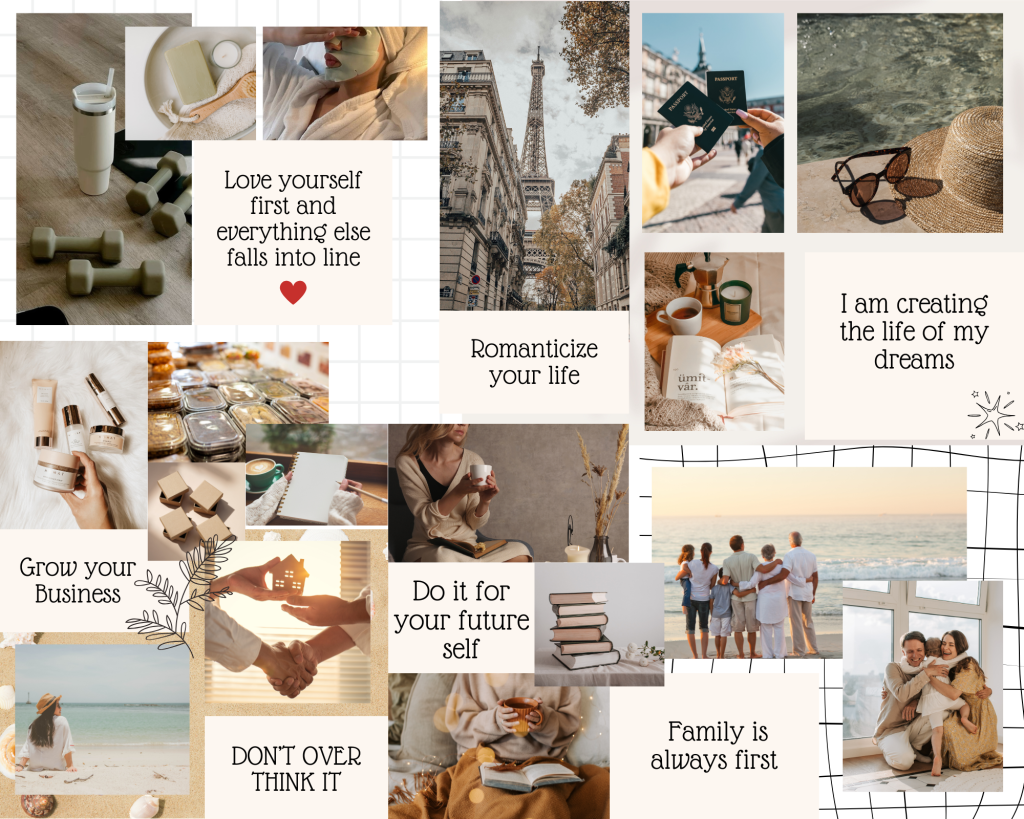
Key Features:
- Customizable Templates: Use platforms like Canva or apps like Pinterest to design your board easily.
- Accessible Anywhere: Save your vision board on your phone, desktop, or cloud storage for constant inspiration.
- Eco-Friendly: No physical materials are required, making it a sustainable option.
How to Create It:
- Choose a design platform such as Canva, PicMonkey, or Pinterest.
- Collect high-quality images, quotes, and icons from online sources like Unsplash, Pixabay, or Pinterest itself.
- Arrange the visuals in a cohesive layout, utilizing themes like “Dream Career” or “Travel Goals.”
- Save your board as your phone or desktop wallpaper, or print it for a physical reminder.
Best For:
- People who prefer digital organization tools.
- Anyone who wants their vision board accessible on the go.
Example Goals:
- Launch a successful online business.
- Save for a tech upgrade.
- Travel to international destinations.
5. The Mood Board
A mood board is designed to evoke a specific feeling or aesthetic rather than focus solely on tangible goals. It’s perfect for visualizing how you want your life or a particular project to feel.
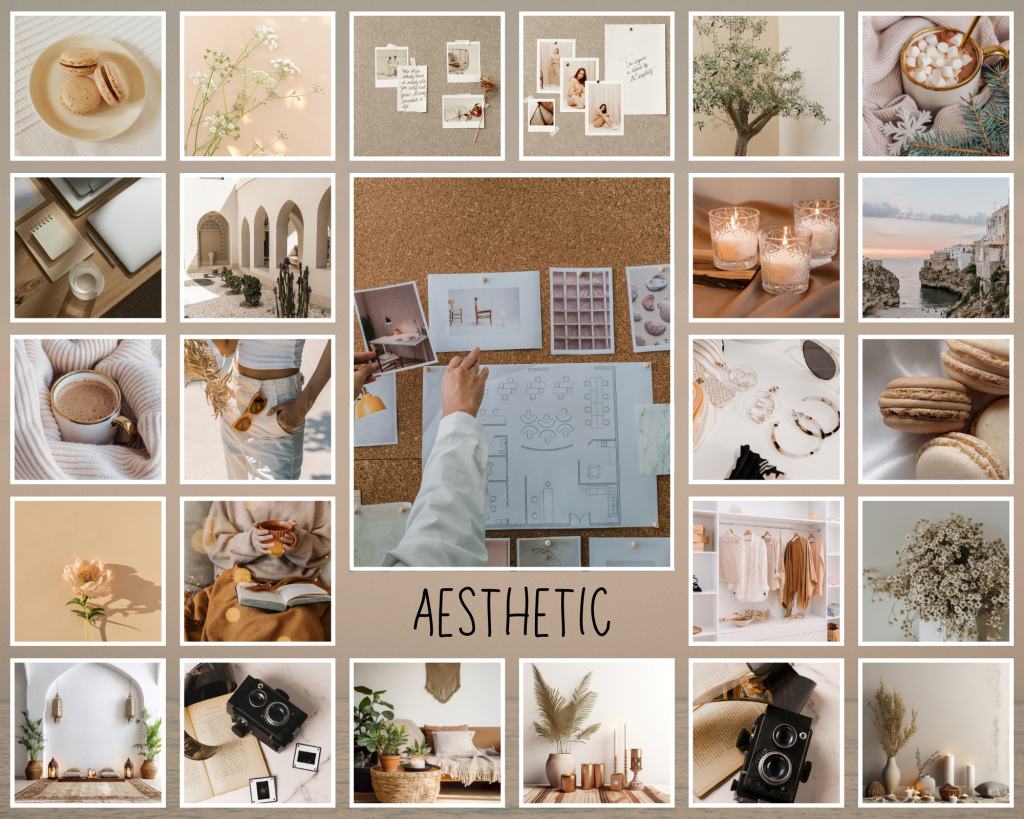
Key Features:
- Color Swatches: Use colors that align with the mood or vibe you want to achieve, such as calming blues for relaxation or vibrant yellows for energy.
- Textures and Patterns: TIncorporatematerials like fabric swatches, wallpapers, or printed textures. to create a tactile experience
- Aesthetic Images: Add inspirational images representing the overall “mood,” such as serene landscapes or chic interior designs.
How to Create It:
- For your mood board, select a core theme, such as “calm and balance” or “creative energy.”
- Choose visual elements that evoke the desired mood, including photos, swatches, and inspirational quotes.
- Arrange the materials in overlapping layers to create a dynamic, artistic look.
- Include personal touches like hand-drawn sketches or handwritten notes for extra meaning.
Best For:
- Setting an aesthetic tone for a space, project, or lifestyle.
- Visualizing abstract goals, like feeling more confident or grounded.
Example Goals:
- Design a relaxing home environment.
- Foster a more creative mindset.
- Embody a personal style or aesthetic.
6. The College Board
The collage board is a creative and artistic approach to vision boarding, perfect for those who enjoy mixing mediums and experimenting with layout.
Key Features:
- Mixed Media: Combine photos, magazine cutouts, handwritten notes, and small objects to create a vibrant, layered design.
- Freeform Layout: Arrange elements in a non-linear, artistic way for a playful and spontaneous feel.
- Personalization: Incorporate drawings, doodles, or keepsakes like ticket stubs or pressed flowers.
How to Create It:
- Gather various materials, such as old magazines, printed images, stickers, and colorful paper.
- Choose a sturdy base, such as a corkboard, poster board, or canvas.
- Layer your elements freely, experimenting with size, color, and overlapping shapes.
- Add final touches like glitter, stamps, or handwritten notes to make it uniquely yours.
Best For:
- Individuals who love artistic expression.
- People who have varied or multi-faceted goals.
7. The Themed Vision Board
A themed vision board allows you to focus on a single area of your life, such as career, health, or relationships, to explore your specific aspirations more deeply.
Key Features:
- A singular focus ensures clarity and intentionality.
- Incorporates detailed images, quotes, and action steps relevant to the theme.
How to Create It:
- Pick a theme (e.g., “Career Advancement” or “Wellness Goals”).
- Gather materials specific to that area, like images of your dream office, healthy meals, or relationship milestones.
- Use motivational quotes that align with the theme.
Best For:
- People looking to address one major area of life at a time.
- Maintaining laser focus on specific aspirations.
8. The Chalkboard Vision Board
A chalkboard vision board is perfect for flexibility and easy updates, allowing you to adjust goals and ideas on the fly.
Key Features:
- Write and erase goals as they evolve.
- Ideal for temporary goals or brainstorming sessions.
How to Create It:
- Use a chalkboard or whiteboard as your base.
- Write down goals, draw visuals, or add magnetic images for variety.
- Update it regularly as you achieve goals or set new ones.
Best For:
- Those who prefer a dynamic, ever-changing vision board.
- Goal-setters who need flexibility and adaptability.
9. The Yearly Vision Board
A yearly vision board focuses on what you want to achieve within a specific year, making it great for tracking progress on short-term goals.
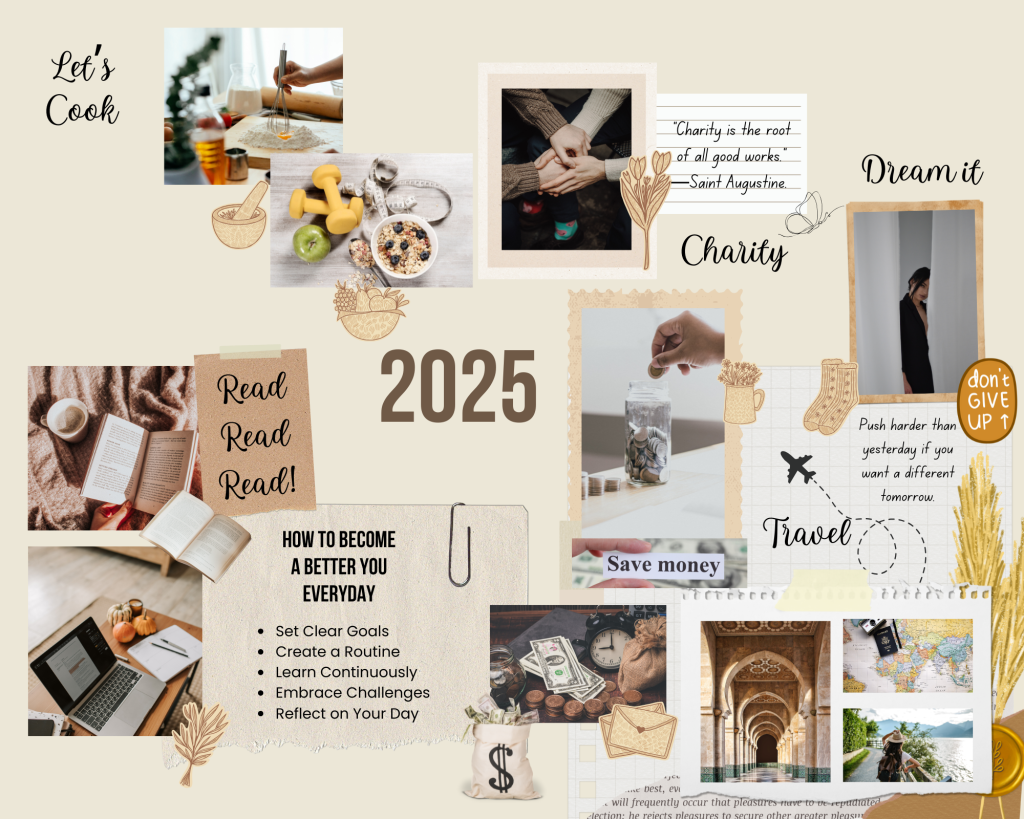
Key Features:
- Highlights annual milestones and priorities.
- Uses a timeline to map out goals across months or quarters.
How to Create It:
- Set yearly goals for areas like career, health, or personal growth.
- Create sections for each month or quarter to track progress.
- Use dated markers to hold yourself accountable.
10. The Family Vision Board
Collaborate with family members to create a shared vision board that reflects collective dreams and goals.
Key Features:
- Focuses on shared aspirations, like vacations, home improvements, or family traditions.
- Encourages bonding and communication.
How to Create It:
- Gather input from all family members.
- Use a large board to include everyone’s goals.
- Incorporate photos, quotes, and shared bucket list items.
Best For:
- Families working toward common goals.
- Building teamwork and strengthening relationships.
11. The Photo-Only Vision Board
A photo-only vision board uses images to create a visually impactful design, leaving out words entirely.
Key Features:
- Focuses solely on imagery for clarity and visual inspiration.
- Great for creative or non-verbal thinkers.
How to Create It:
- Choose high-quality photos that represent your goals and dreams.
- Arrange them in a collage or grid.
- Use powerful visuals that evoke emotions and motivation.
Best For:
- Visual learners.
- People who feel inspired by strong imagery rather than text.
12. The DIY Vision Journal
A vision journal oisa private, portable alternative to a traditional board,. It allowsfor flexibility and deeper reflection.
Key Features:
- Combines journaling with vision board elements.
- Ideal for introverts or those who prefer discretion.
How to Create It:
- Use a notebook or sketchpad as your base.
- Include images, quotes, and drawings on each page.
- Leave space for writing reflections and progress updates.
Best For:
- Journaling enthusiasts.
- People who prefer portable and private goal-setting tools.
13. The Career Success Vision Board
This vision board hones in on professional goals, such as career advancement, skill development, or networking opportunities.
Key Features:
- Focuses on job titles, certifications, and work environments.
- Includes action plans and motivational elements.
How to Create It:
- Select visuals of your dream job, office, or mentor.
- Add quotes or affirmations about professional success.
- Include tangible goals like “Earn a promotion by Q3” or “Complete a certification.”
Best For:
- Professionals aiming for career growth.
- Entrepreneurs visualizing business success.
14. The Relationship Goals Vision Board
Highlight the kind of relationships you want to nurture, whether romantic, platonic, or familial.
Key Features:
- Includes photos of loved ones or ideal relationship scenarios.
- Uses affirmations and quotes about love and connection.
How to Create It:
- Add photos of happy moments with loved ones.
- Include visuals of activities or events you want to share with them.
- Write affirmations like “I attract healthy and fulfilling relationships.”
Best For:
- Strengthening existing relationships.
- Manifesting new, meaningful connections.
15. The Financial Freedom Board
Focus on financial goals, such as savings, investments, or major purchases.
Key Features:
- Highlights monetary aspirations and strategies.
- Uses visuals like dollar signs, investment graphs, or dream purchases.
How to Create It:
- Add images of financial milestones, such as a paid-off home or savings target.
- Include quotes like “Money flows to me with ease.”
- Add action steps, such as “Save $500/month.”
Best For:
- Building wealth and financial security.
- Tracking money-related goals.
16. The Bucket List Vision Board
A bucket list vision board captures your life’s biggest dreams and adventures.
Key Features:
- Includes goals for travel, personal growth, or unique experiences.
- Focuses on once-in-a-lifetime aspirations.
How to Create It:
- Add images of bucket list activities (e.g., skydiving, visiting the Eiffel Tower).
- Highlight deadlines or steps to achieve each dream.
- Incorporate inspirational quotes about living life to the fullest.
Best For:
- Adventurers and dreamers.
- Long-term visionaries.
17. The Seasonal Vision Board
Focus on short-term goals and refresh your vision board each season for renewed focus.
Key Features:
- Targets quarterly goals or habits.
- Incorporates seasonal themes (e.g., fall leaves, summer beaches).
How to Create It:
- Choose 3-5 goals for the season.
- Use seasonal visuals for inspiration.
- Update regularly to stay on track.
Best For:
- Short-term planners.
- Staying motivated throughout the year.
18. The Pinterest-Inspired Vision Board
A Pinterest-inspired board allows you to bring your curated pins to life.
Key Features:
- Combines printed Pinterest pins with your personal touch.
- Offers a cohesive and stylish design.
How to Create It:
- Print your favorite Pinterest images.
- Arrange them with complementary colors and themes.
- Add handwritten notes or embellishments for customization.
Best For:
- Style-conscious individuals.
- Fans of Pinterest aesthetics.
19. The Vision Wall
Dedicate an entire wall to your goals, ideal for multi-faceted aspirations.
Key Features:
- Large, dynamic space for diverse goals.
- Includes various sections or categories.
How to Create It:
- Use a corkboard, whiteboard, or a section of your wall.
- Divide the wall into categories like “Career,” “Health,” and “Relationships.”
- Add images, quotes, and visuals to each section.
Best For:
- Big dreamers with numerous goals.
- Creative spaces with room to spare.
20. The Affirmations Vision Board
Focus on empowering words and phrases to build positivity and motivation.
Key Features:
- Uses affirmations as the central element.
- Pairs words with uplifting visuals.
How to Create It:
- Write affirmations like “I am capable of achieving greatness.”
- Pair each affirmation with an image or symbol.
- Arrange in a clean, visually inspiring layout.
Best For:
- Boosting self-confidence.
- Cultivating a positive mindset.
How to Use Your Vision Board Effectively
1. Placement Tips
- Place your vision board where you’ll see it daily, such as a workspace, bedroom, or phone background.
- Choose a spot that reminds you to stay focused and motivated.
2. Review and Update Regularly
- Revisit your board weekly or monthly to track progress.
- Update it as you achieve goals or refine your aspirations.
3. Pair with Journaling or Meditation
- Reflect on your goals during journaling sessions.
- Use meditation to visualize success and align your actions with your intentions.
Conclusion
Creating a vision board is more than just an arts-and-crafts project; it’s a powerful tool for manifesting your dreams and staying motivated throughout the year. Vision boards help you clarify your goals, keep your focus sharp, and make your aspirations feel tangible.
Whether you resonate with a minimalist design, a digital board you can access on the go, or a themed board tailored to your career or relationships, these 20 unique ideas offer something for everyone. By tapping into your creativity and aligning your vision with actionable steps, you’ll find that achieving your dreams feels not just possible but inevitable.
Start your vision board today, and let it guide you toward an incredible 2025 filled with purpose, growth, and success!


